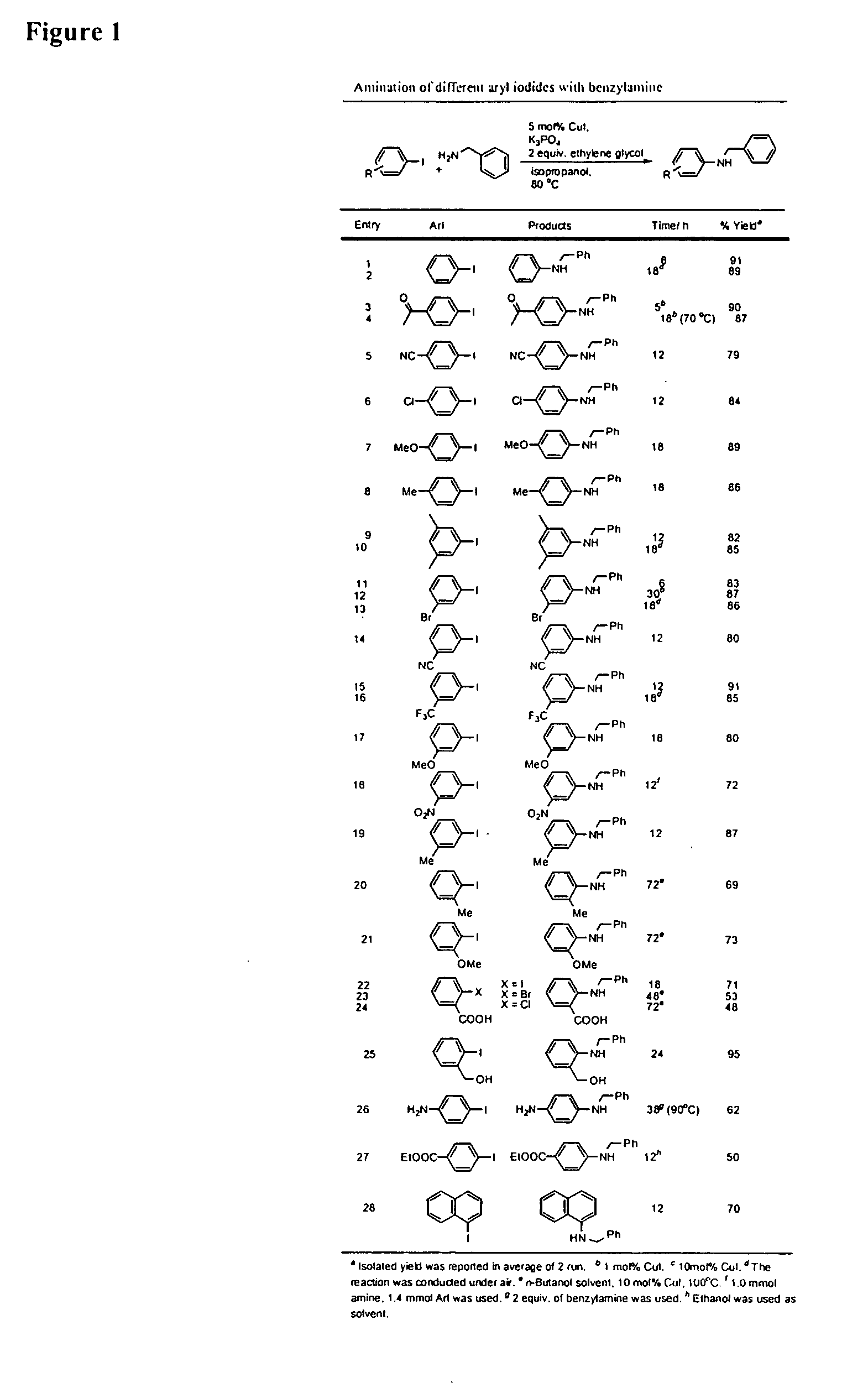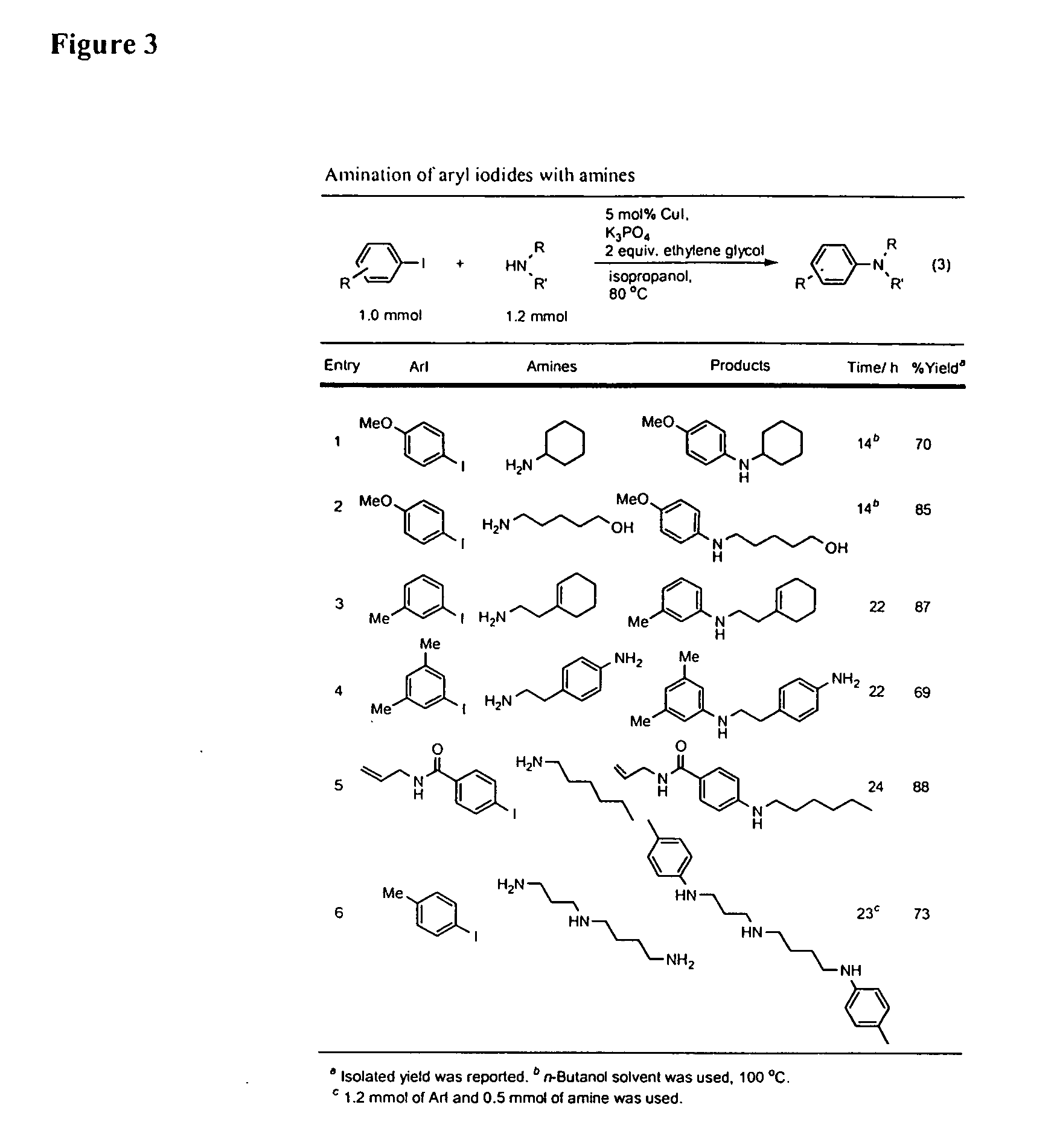Copper-catalyzed formation of carbon heteroatom and carbon-carbon bonds
a carbon heteroatom and carbon-carbon bond technology, applied in chemical/physical processes, group 5/15 element organic compounds, urea derivative preparations, etc., can solve the problem of detracting from the allure of these powerful methods the ever-increasing cost of palladium, and achieves the effect of low cost of copper and inexpensive practi
- Summary
- Abstract
- Description
- Claims
- Application Information
AI Technical Summary
Benefits of technology
Problems solved by technology
Method used
Image
Examples
example 1
General Procedure A—Arylations Using Aryl or Heteroaryl Iodides
[0516] An oven-dried resealable Schlenk tube was charged with CuI (2.0 mg, 0.0105 mmol, 1.0 mol %), amide (1.2 mmol) and K3PO4 (2.1 mmol), evacuated and backfilled with argon. trans-1,2-Cyclohexanediamine (13 μL, 0.108 mmol, 11 mol %), dodecane (235 μL), aryl iodide (1.0 mmol) and dioxane (1.0 mL) were added under argon. The Schlenk tube was sealed and the reaction mixture was stirred magnetically at 110° C. for 23 h. The resulting suspension was cooled to room temperature and filtered through a 0.5×1 cm pad of silica gel eluting with 10 mL of ethyl acetate. The filtrate was concentrated and the residue was purified by flash chromatography to afford pure product.
example 2
General Procedure B—Arylations Using Aryl or Heteroaryl Iodides
[0517] To a flame-dried resealable Schlenk tube was added CuI (2.0 mg, 0.0105 mmol, 1.0 mol %), the heterocycle (1.2 mmol) and K3PO4 (2.1 mmol), evacuated twice and back-filled with argon. Dodecane (45 μL, 0.20 mmol), 5-iodo-m-xylene (144 μL, 1.0 mmol), trans-1,2-cyclohexanediamine (12 μL, 0.10 mmol, 10 mol %) and dioxane (1.0 mL) were added under argon. The Schlenk tube was sealed and the reaction was stirred with heating via an oil bath at 110° C. for 20 hours. The reaction mixture was cooled to ambient temperature, diluted with 2-3 mL ethyl acetate, and filtered through a plug of silica gel eluting with 10-20 mL of ethyl acetate. The filtrate was concentrated and the resulting residue was purified by column chromatography to provide the purified product.
example 3
General Procedure C—Arylations Using Aryl or Heteroaryl Bromides
[0518] An oven-dried resealable Schlenk tube containing a stirbar was charged with CuI (20 mg, 0.1 mmol, 10 mol %), amide (1.2 mmol) and K3PO4 (425 mg, 2 mmol), evacuated and backfilled with argon. trans-1,2-Diaminocyclohexane (11.5 mg, 0.1 mmol), heteroaryl bromide (1.0 mmol) and dioxane (1 ml) were injected, and under a flow of argon, the septum was replaced by a Teflon screw cap. The tube was sealed, and the mixture was stirred and heated in an oil bath at 110° C. for the time specified. The resulting mixture was cooled to room temperature and filtered through Celite with dichloromethane. The filtrate was concentrated under reduced pressure and the residue chromatographed on silica gel.
PUM
| Property | Measurement | Unit |
|---|---|---|
| temperatures | aaaaa | aaaaa |
| mol % | aaaaa | aaaaa |
| temperature | aaaaa | aaaaa |
Abstract
Description
Claims
Application Information
 Login to View More
Login to View More - R&D
- Intellectual Property
- Life Sciences
- Materials
- Tech Scout
- Unparalleled Data Quality
- Higher Quality Content
- 60% Fewer Hallucinations
Browse by: Latest US Patents, China's latest patents, Technical Efficacy Thesaurus, Application Domain, Technology Topic, Popular Technical Reports.
© 2025 PatSnap. All rights reserved.Legal|Privacy policy|Modern Slavery Act Transparency Statement|Sitemap|About US| Contact US: help@patsnap.com



